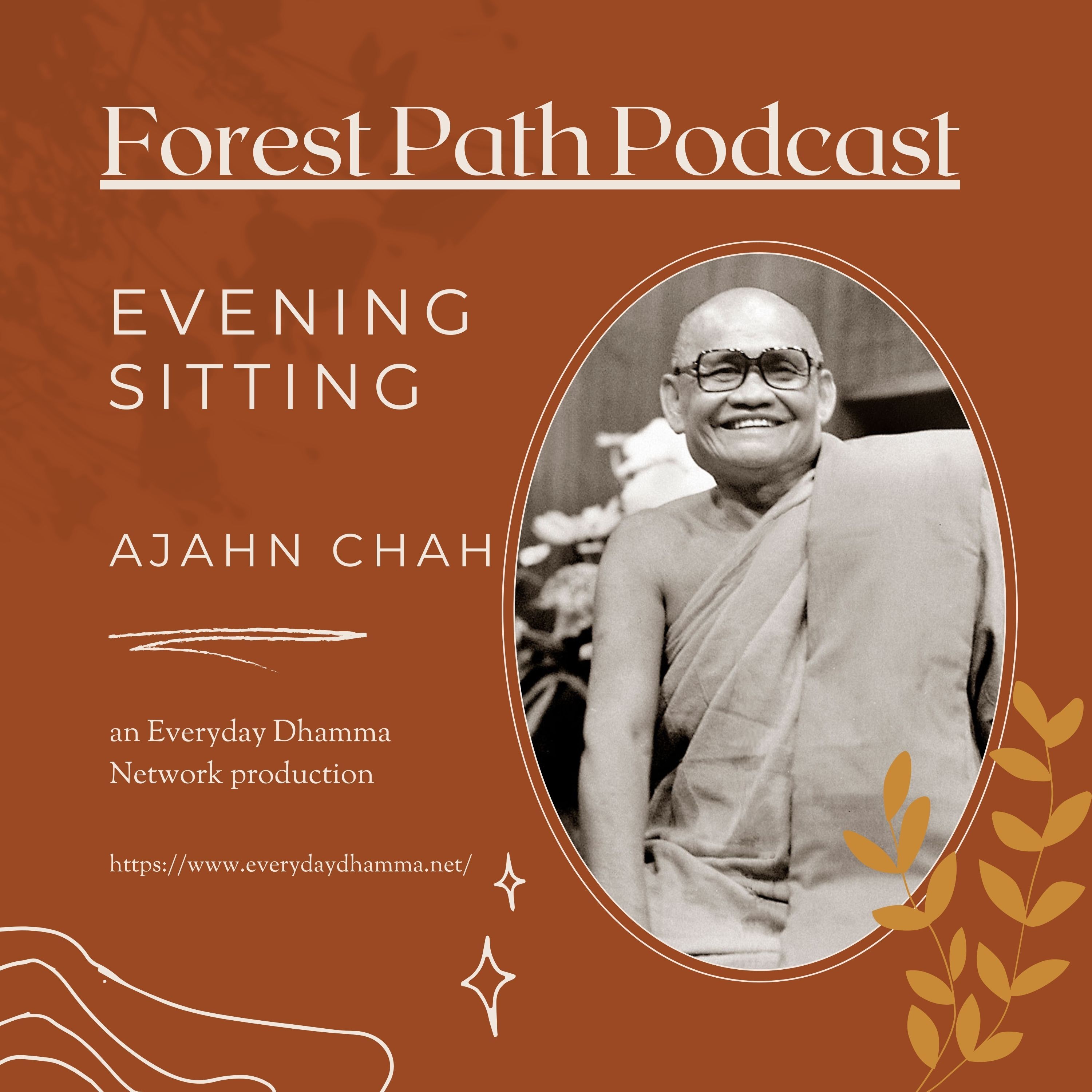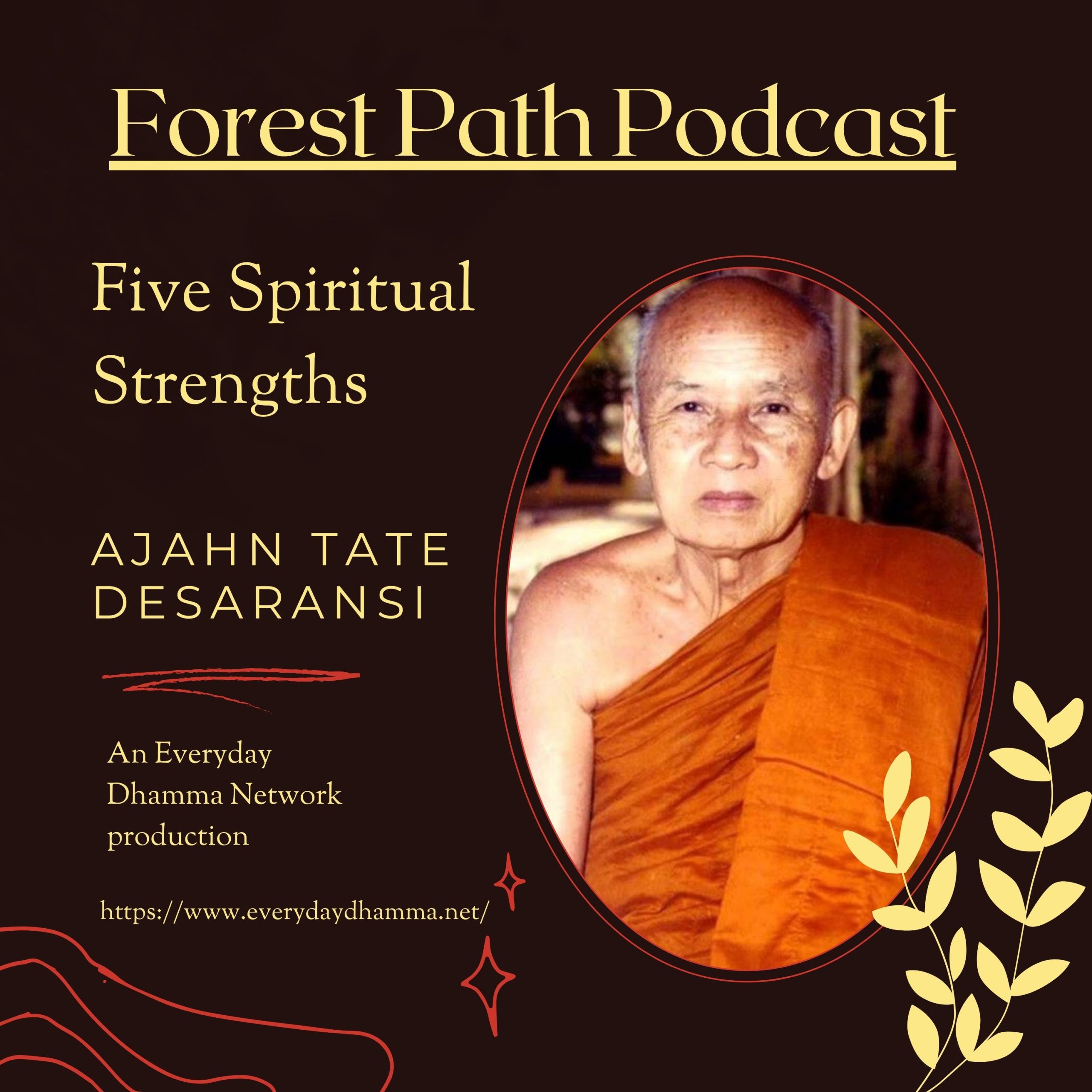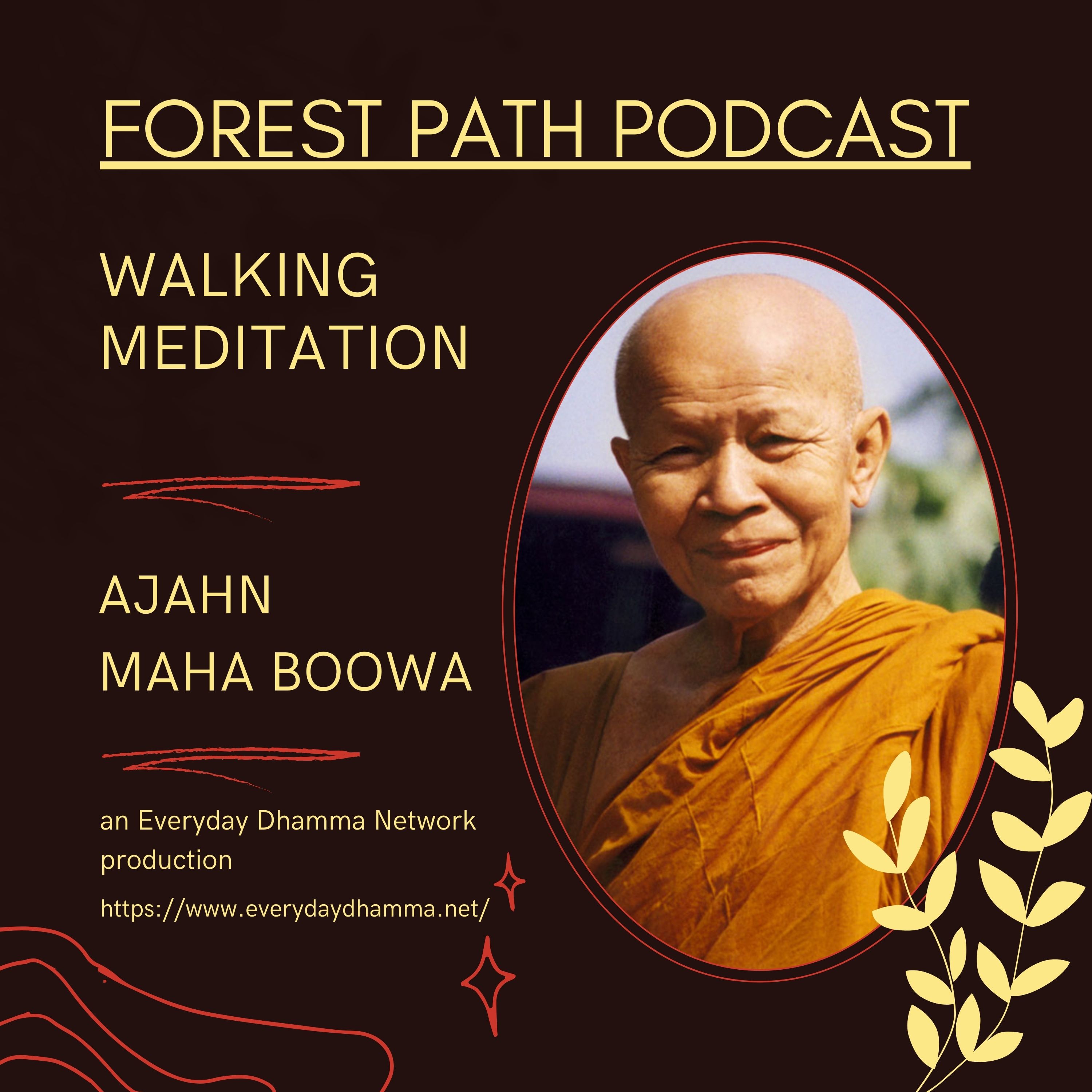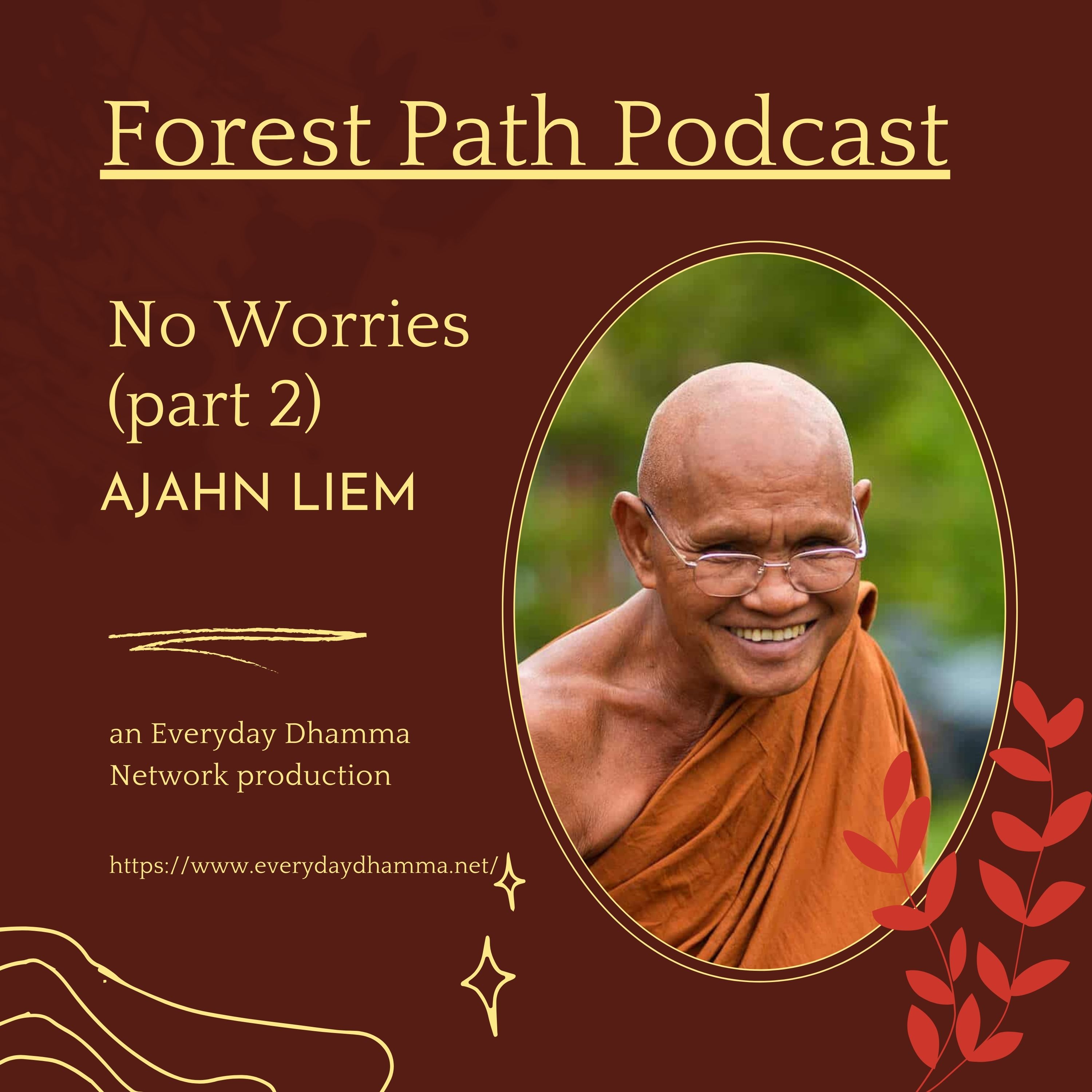Episode Transcript
Evening Sitting
by Ajahn Chah
I WOULD LIKE TO ASK you about your practice. You have all been practising meditation here, but are you sure about the practice yet? Ask yourselves, are you condent about the practice yet? These days there are all sorts of meditation teachers around, both monks and lay teachers, and I’m afraid it will cause you to be full of doubts and uncertainty about what you are doing. This is why I am asking. As far as Buddhist practice is concerned, there is really nothing greater or higher than these teachings of the Buddha which you have been practising with here. If you have a clear understanding of them, it will give rise to an absolutely rm and unwavering peace in your heart and mind.
Making the mind peaceful is known as practising meditation, or practising samadhi. The mind is something which is extremely changeable and unreliable. Observing from your practice so far, have you seen this yet? Some days you practise sitting meditation and in no time at all the mind is calm, other days you sit and whatever you do there’s no calm the mind constantly struggles to get away, until it eventually does. Some days it goes well, some days it’s awful. This is the way the mind displays these dierent conditions for you to see. You must understand that the eight factors of the Noble Eightfold Path1 merge in sila, samadhi and panya. They don’t come together anywhere else. This means that when you bring the factors of your practice together, there must be sla, there must be samadhi and there must be panya present together in the mind. It means that in practising meditation right here and now, you are creating the causes for the Path to arise in a very direct way.
In sitting meditation you are taught to close your eyes so that you don’t spend your time looking at different things. This is because the Buddha was teaching that you should know your own mind. Observe the mind. If you close your eyes, your attention will naturally be turned inwards towards the mind the source of many dierent kinds of knowledge. This is a way of training the mind to give rise to samadhi.
Once sitting with the eyes closed, establish awareness with the breath make awareness of the breath more important than anything else. This means you bring awareness to follow the breath, and by keeping with it, you will know that place which is the focal point of sati, the focal point of the knowing and the focal point of the mind’s awareness. Whenever these factors of the path are working together, you will be able to watch and see your breath, feelings, mind and arammana as they are in the present moment. Ultimately, you will know that place which is both the focal point of samadhi and the unication point of the Path factors.
When developing samadhi, fix attention on the breath and imagine that you are sitting alone with absolutely no other people and nothing else around to bother you. Develop this perception in the mind, sustaining it until the mind completely lets go of the world outside and all that is left is simply the knowing of the breath entering and leaving. The mind must set aside the external world. Don’t allow yourself to start thinking about this person who is sitting over here, or that person who is sitting over there.
Don’t give space to any thoughts that will give rise to confusion or agitation in the mind it’s better to throw them out and be done with them. There is no one else here, you are sitting all alone. Develop this perception until all the other memories, perceptions and thoughts concerning other people and things subside, and you’re no longer doubting or wondering about the other people or things around you. Then you can fix your attention solely on the in-breaths and out-breaths. Breathe normally. Allow the in-breaths and the out-breaths to continue naturally, without forcing them to be longer or shorter, stronger or weaker than normal. Allow the breath to continue in a state of normality and balance, and then sit and observe it entering and leaving the body.
Once the mind has let go of external mind-objects, it means you will no longer feel disturbed by the sound of traffic or other noises. You won’t feel irritated with anything outside. Whether it’s forms, sounds or whatever, they won’t be a source of disturbance, because the mind won’t be paying attention to them it will become centred upon the breath.
If the mind is agitated by dierent things and you can’t concentrate, try taking an extra-deep breath until the lungs are completely full, and then release all the air until there is none left inside. Do this several times, then re-establish awareness and continue to develop concentration. Having re-established mindfulness, it’s normal that for a period the mind will be calm, then change and become agitated again. When this happens, make the mind firm, take another deep breath and subsequently expel all the air from your lungs. Fill the lungs to capacity again for a moment and then re-establish mindfulness on the breathing. Fix sati on the in-breaths and the out-breaths, and continue to maintain awareness in this way.
The practice tends to be this way, so it will have to take many sittings and much effort before you become prociffent. Once you are, the mind will let go of the external world and remain undisturbed. Mind-objects from the outside will be unable to penetrate inside and disturb the mind itself. Once they are unable to penetrate inside, you will see the mind. You will see the mind as one object of awareness, the breath as another and mind-objects as another. They will all be present within the field of awareness, centred at the tip of your nose. Once sati is rmly established with the in-breaths and out-breaths, you can continue to practise at your ease. As the mind becomes calm, the breath, which was originally coarse, becomes correspondingly lighter and more rened. The object of mind also becomes increasingly subtle and rened. The body feels lighter and the mind itself feels progressively lighter and unburdened. The mind lets go of external mind-objects and you continue to observe internally.
From here onwards your awareness will be turned away from the world outside and be directed inwards to focus on the mind. Once the mind has gathered together and become concentrated, maintain awareness at that point where the mind becomes focused. As you breathe, you will see the breath clearly as it enters and leaves, sati will be sharp and awareness of mind-objects and mental activity will be clearer. At that point you will see the characteristics of sila, samadhi and panya and the way in which they merge together. This is known as the unication of the Path factors. Once this unication occurs, your mind will be free from all forms of agitation and confusion. It will become one-pointed and this is what is known as samadhi.
When you focus attention in just one place, in this case the breath, you gain a clarity and awareness because of the uninterrupted presence of sati. As you continue to see the breath clearly, sati will become stronger and the mind will become more sensitive in many different ways. You will see the mind in the centre of that place (the breath), one-pointed with awareness focused inwards, rather than turning towards the world outside. The external world gradually disappears from your awareness and the mind no longer goes to perform any work on the outside. It’s as if you’ve come inside your `house’, where all your sense faculties have come together to form one compact unit. You are at ease and the mind is free from all external objects. Awareness remains with the breath and over time it will penetrate deeper and deeper inside, becoming progressively more refined.
Ultimately, awareness of the breath becomes so refined that the sensation of the breath seems to disappear. You could say either that awareness of the sensation of the breath has disappeared, or that the breath itself has disappeared. Then there arises a new kind of awareness awareness that the breath has disappeared. In other words, awareness of the breath becomes so rened that it’s difficult to define it.
So it might be that you are just sitting there and there’s no breath. Really, the breath is still there, but it has become so rened that it seems to have disappeared. Why? Because the mind is at its most refined, with a special kind of knowing. All that remains is the knowing. Even though the breath has vanished, the mind is still concentrated with the know- ledge that the breath is not there. As you continue, what should you take up as the object of meditation? Take this very knowing as the meditation object in other words the knowledge that there is no breath and sustain this. You could say that a specific kind of knowledge has been established in the mind.
At this point, some people might have doubts arising, because it is here that nimitta1 can arise. These can be of many kinds, including both forms and sounds. It is here that all sorts of unexpected things can arise in the course of the practice. If nimitta do arise (some people have them, some don’t) you must understand them in accordance with the truth. Don’t doubt or allow yourself to become alarmed.
At this stage, you should make the mind unshakeable in its concentration and be especially mindful. Some people become startled when they notice that the breath has disappeared, because they’re used to having the breath there. When it appears that the breath has gone, you might panic or become afraid that you are going to die. Here you must establish the understanding that it is just the nature of the practice to progress in this way. What will you observe as the object of meditation now? Observe this feeling that there is no breath and sustain it as the object of awareness as you continue to meditate. The Buddha described this as the firmest, most unshakeable form of samadhi. There is just one rm and unwavering object of mind. When your practice of samadhi reaches this point, there will be many unusual and rened changes and transformations taking place within the mind, of which you can be aware. The sensation of the body will feel at its lightest or might even disappear altogether. You might feel like you are oating in mid-air and seem to be completely weightless. It might be like you are in the middle of space and wherever you direct your sense faculties they don’t seem to register anything at all. Even though you know the body is still sitting there, you experience complete emptiness. This feeling of emptiness can be quite strange.
As you continue to practise, understand that there is nothing to worry about. Establish this feeling of being relaxed and unworried, securely in the mind. Once the mind is concentrated and one-pointed, no mind-object will be able to penetrate or disturb it, and you will be able to sit like this for as long as you want. You will be able to sustain concentration without any feelings of pain and discomfort.
Having developed samadhi to this level, you will be able to enter or leave it at will. When you do leave it, it’s at your ease and convenience. You withdraw at your ease, rather than because you are feeling lazy or tired. You withdraw from samadhi because it is the appropriate time to withdraw, and you come out of it at your will.
This is samadhi; you are relaxed and at your ease. You enter and leave it without any problems. The mind and heart are at ease. If you genuinely have samadhi like this, it means that sitting meditation and entering samadhi for just thirty minutes or an hour will enable you to remain cool and peaceful for many days afterwards. Experiencing the effects of samadhi like this for several days has a purifying effect on the mind whatever you experience will become an object for contemplation. This is where the practice really begins. It’s the fruit which arises as samadhi matures.
Samadhi performs the function of calming the mind. Samadhi performs one function, sla performs one function and panya performs another function. These characteristics, which you are focusing attention on and developing in the practice are linked, forming a circle. This is the way they manifest in the mind. Sila, samadhi and panya arise and mature from the same place. Once the mind is calm, it will become progressively more restrained and composed due to the presence of panya and the power of samadhi.
As the mind becomes more composed and rened, this gives rise to an energy which acts to purify sla. Greater purity of sla facilitates the development of stronger and more rened samadhi, and this in turn supports the maturing of panya. They assist each other in this way. Each aspect of the practice acts as a supporting factor for the other ones in the end these terms becoming synonymous. As these three factors continue to mature together, they form one complete circle, ultimately giving rise to magga. Magga is a synthesis of these three functions of the practice working smoothly and consistently together. As you practise, you have to preserve this energy. It is the energy which will give rise to vipassana1 or panya. Having reached this stage (where panya is already functioning in the mind, independent of whether the mind is peaceful or not), panya will provide a consistent and independent energy in the practice. You see that whenever the mind is not peaceful, you shouldn’t attach, and even when it is peaceful, you shouldn’t attach. Having let go of the burden of such concerns, the heart will accordingly feel much lighter. Whether you experience pleasant mind-objects or unpleasant mind-objects, you will remain at ease. The mind will remain peaceful in this way.
Another important thing is to see that when you stop doing formal meditation practice, if there is no wisdom functioning in the mind, you will give up the practice altogether without any further contemplation, development of awareness or thought about the work which still has to be done. In fact, when you withdraw from samadhi, you know clearly in the mind that you have withdrawn. Having withdrawn you should continue to conduct yourself in a normal manner. Maintain mindfulness and awareness at all times. It isn’t that you only practise meditation in the sitting posture samadhi means the mind which is rm and unwavering. As you go about your daily life, make the mind firm and steady and maintain this sense of steadiness as the object of mind at all times. You must be practising sati and sampajanya continuously.
After you get up from the formal sitting practice and go about your business walking, riding in cars and so on whenever your eyes see a form or your ears hear a sound, maintain awareness. As you experience mind- objects which give rise to liking and disliking, try to consistently maintain awareness of the fact that such mental states are impermanent and uncer- tain. In this way the mind will remain calm and in a state of `normality’.
As long as the mind is calm, use it to contemplate mind-objects. Contemplate the whole of this form, the physical body. You can do this at any time and in any posture: whether doing formal meditation practice, relaxing at home, out at work, or in whatever situation you find yourself. Keep the meditation and the reflection going at all times. Just going for a walk and seeing dead leaves on the ground under a tree can provide an opportunity to contemplate impermanence. Both we and the leaves are the same: when we get old, we shrivel up and die. Other people are all the same. This is raising the mind to the level of vipassana, contemplating the truth of the way things are, the whole time. Whether walking, standing, sitting or lying down, sati is sustained evenly and consistently. This is practising meditation correctly you have to follow the mind closely, checking it at all times.
Practising here and now at seven o’clock in the evening, we have sat and meditated together for an hour and now stopped. It might be that your mind has stopped practising completely and hasn’t continued with the reflection. That’s the wrong way to do it. When we stop, all that should stop is the formal meeting and sitting meditation. You should continue practising and developing awareness consistently, without letting up.
I’ve often taught that if you don’t practise consistently, it’s like drops of water. It’s like drops of water because the practice is not a continuous, uninterrupted ow. Sati is not sustained evenly. The important point is that the mind does the practice and nothing else. The body doesn’t do it. The mind does the work, the mind does the practice. If you understand this clearly, you will see that you don’t necessarily have to do formal sitting meditation in order for the mind to know samadhi. The mind is the one who does the practice. You have to experience and understand this for yourself, in your own mind.
Once you do see this for yourself, you will be developing awareness in the mind at all times and in all postures. If you are maintaining sati as an even and unbroken ow, it’s as if the drops of water have joined to form a smooth and continuous ow of running water. Sati is present in the mind from moment to moment and accordingly there will be awareness of mind-objects at all times. If the mind is restrained and composed with uninterrupted sati, you will know mind-objects each time that wholesome and unwholesome mental states arise. You will know the mind that is calm and the mind that is confused and agitated. Wherever you go you will be practising like this. If you train the mind in this way, your meditation will mature quickly and successfully.
Please don’t misunderstand. These days it’s common for people to go on vipassana courses for three or seven days, where they don’t have to speak or do anything but meditate. Maybe you have gone on a silent meditation retreat for a week or two, afterwards returning to your normal daily life. You might have left thinking that you’ve `done vipassana’ and, because you feel that you know what it’s all about, then carry on going to parties, discos and indulging in different forms of sensual delight. When you do it like this, what happens? There won’t be any of the fruits of vipassana left by the end of it. If you go and do all sorts of unskilful things, which disturb and upset the mind, wasting your previous efforts, then next year go back again and do another retreat for seven days or a few weeks, then come out and carry on with the parties, discos and drinking, that isn’t true practice. It isn’t pat.ipada1 or the path to progress.
You need to make an effort to renounce. You must contemplate until you see the harmful effects which come from such behaviour. See the harm in drinking and going out on the town. Reflect and see the harm inherent in all the different kinds of unskilful behaviour which you indulge in, until it becomes fully apparent. This would provide the impetus for you to take a step back and change your ways. Then you would nd some real peace. To experience peace of mind you have to clearly see the disadvantages and danger in such forms of behaviour. This is practising in the correct way. If you do a silent retreat for seven days, where you don’t have to speak to or get involved with anybody, and then go chatting, gossiping and overindulging for another seven months, how will you gain any real or lasting benet from those seven days of practice?
I would encourage all the laypeople here who are practising to develop awareness and wisdom to understand this point. Try to practise consistently. See the disadvantages of practising insincerely and inconsistently, and try to sustain a more dedicated and continuous eort in the prac- tice. Just this much. It can then become a realistic possibility that you might put an end to the kilesa. But that lifestyle of not speaking and not playing around for seven days, followed by six months of complete sensual indulgence, without any mindfulness or restraint, will just lead to the squandering of any gains made from the meditation there won’t be anything left. It’s like going to work for a day and earning twenty pounds, but then going out and spending thirty pounds on food and things in the same day; would any money be saved? It would all be gone. It’s just the same with the meditation.
This is a form of reminder to you all, so I will ask for your forgiveness. It’s necessary to speak in this way, so that those aspects of the practice which are at fault will become clear to you and accordingly, you will be able to give them up. You could say that the reason why you have come to practise is to learn how to avoid doing the wrong things in the future. What happens when you do the wrong things? Doing wrong things leads you to agitation and suering, when there’s no goodness in the mind. It’s not the way to peace of mind. This is the way it is. If you practise on a retreat, not talking for seven days, and then go indulging for a few months, no matter how strictly you practised for those seven days, you won’t derive any lasting value from that practice. Practising that way, you don’t really get anywhere. Many places where meditation is taught don’t really get to grips with or get beyond this problem. Really, you have to conduct your daily life in a consistently calm and restrained way.
In meditation you have to be constantly turning your attention to the practice. It’s like planting a tree. If you plant a tree in one place and after three days pull it up and plant it in a different spot, then after a further three days pull it up and plant it in yet another place, it will just die without producing anything. Practising meditation like this won’t bear any fruit either. This is something you have to understand for yourselves. Contemplate it. Try it out for yourselves when you go home. Get a sapling and plant it in one spot, and every few days, go and pull it up and plant it in a different place. It will just die without ever bearing any fruit. It’s the same doing a meditation retreat for seven days, followed by seven months of unrestrained behaviour, allowing the mind to become soiled, and then going back to do another retreat for a short period, practising strictly without talking and subsequently coming out and being unrestrained again. As with the tree, the meditation just dies none of the wholesome fruits are retained. The tree doesn’t grow, the meditation doesn’t grow. I say practising this way doesn’t bear much fruit.
Actually, I’m not fond of giving talks like this. It’s because I feel sorry for you that I have to speak critically. When you are doing the wrong things, it’s my duty to tell you, but I’m speaking out of compassion for you. Some people might feel uneasy and think that I’m just scolding them. Really, I’m not just scolding you for its own sake, I’m helping to point out where you are going wrong, so that you know. Some people might think, Luang Por (1) is just telling us o,’ but it’s not like that. It’s only once in a long while that I’m able to come and give a talk if I were to give talks like this every day, you would really get upset! But the truth is, it’s not you who gets upset, it’s only the kilesa that are upset. I will say just this much for now.
( 1 Luang Por: `Venerable Father’; a way of addressing elderly monks.)




